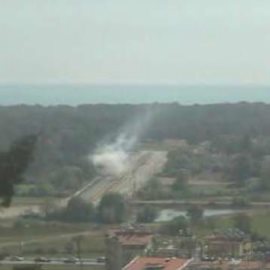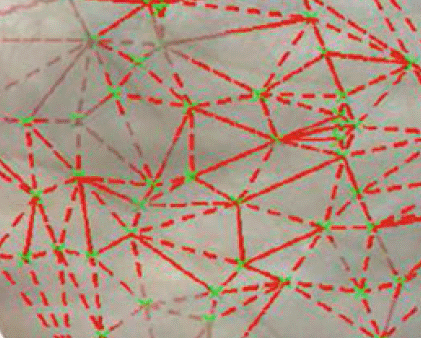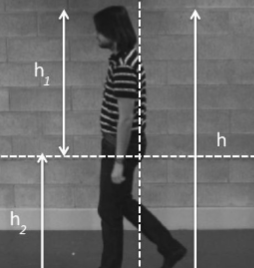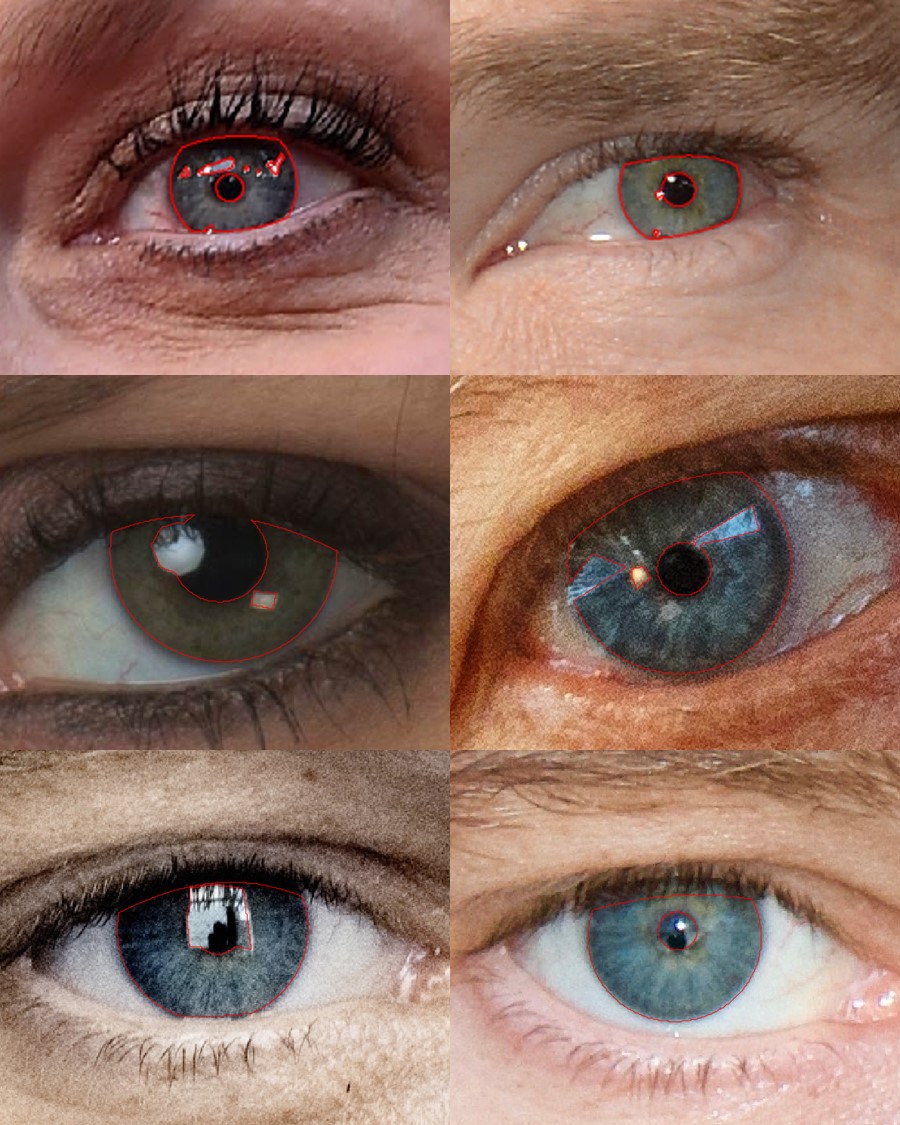Curriculum vitae et studiorum
Updated: Monday, December 01, 2025Academic Curriculum (ITA) (PDF)
Personal information
| Name: | Angelo |
| Surname: | Genovese |
| Email: | angelo.genovese@unimi.it |
| Web: | www.di.unimi.it/genovese |
Contents
1. Short biography2. Teaching and support activities
3. Education and research activities in national and international institutes
4. National and international research projects
5. Participation in national and international research groups
6. Participation as a speaker in international conferences
7. Awards for the research activities
8. Professional and service activities
9. Research activity
10. Publications
1. Short biography
1.1. Current position
Associate ProfessorUniversità degli Studi di Milano
Department of Computer Science
1.2. Education
-
March 2014
Ph.D. in Computer Science (XXVI group) at the Università degli Studi di Milano, Italy.
Thesis title: "Contactless and less-constrained palmprint recognition".
Supervisor: Prof. V. Piuri.
Co-supervisor: Prof. F. Scotti. -
June 2010
M.Sc. Degree in Computer Science and Information Technology from the Università degli Studi di Milano, Italy.
Thesis title: "Three-dimensional processing of contactless fingerprints (in Italian)".
Advisor: Prof. F. Scotti. -
October 2007
B.Sc. Degree in Computer Science from the Università degli Studi di Milano, Italy.
Thesis title: "Analysis and design of a sensing circuit for Rad-Hard memories (in Italian)".
Advisor: Prof. V. Liberali. -
July 2004
Scientific high school diploma from the Liceo Scientifico Leonardo da Vinci, Crema, Italy.
1.3. Employment history
- Associate Professor at the Università degli Studi di Milano, Italy, Department of Computer Science (July 1, 2022 – Present).
- Assistant Professor (tenure track: RTD-B) at the Università degli Studi di Milano, Italy, Department of Computer Science (July 1, 2019 – June 30, 2022).
- Abilitazione Scientifica Nazionale (ASN) in Computer Science, for the sector 01/B1 - Informatica (scientific sector INF/01 - Informatica), II fascia (August 7, 2018 – August 7, 2027).
- Postdoctoral Research Fellow (type A research grant) in the research program: "Advanced methods for less-constrained highly-usable biometric recognition in security applications", at the Università degli Studi di Milano, Italy, Department of Computer Science (August 1, 2016 – June 30, 2019).
- Postdoctoral Research Fellow (type B research grant) in the research program: "Analysis of the functional characteristics of adaptive and less-constrained biometric systems", with funding in the research project PRIN 2010/2011 – GenData 2020, at the Università degli Studi di Milano, Italy, Department of Computer Science (January 1, 2015 – July 31, 2016).
- Postdoctoral Research Fellow (type B research grant) in the research program: "Analysis of the functional characteristics of adaptive and less-constrained biometric systems", with funding in the research project PRIN 2010/2011 – GenData 2020, at the Università degli Studi di Milano, Italy, Department of Computer Science (January 1, 2014 – December 31, 2014).
- Ph.D. student in Computer Science (XXVI group) at the Università degli Studi di Milano, with three-year scholarship (January 1, 2011 – December 31, 2013).
- Scholarship in the research project: "Computational intelligence techniques for environmental and infrastructure monitoring", at the Università degli Studi di Milano (September 1, 2010 – December 31, 2010).
2. Teaching and support activities
2.1. Teaching activities for undergraduate and graduate courses
Teacher for the following courses, M.Sc. Degree in Artificial Intelligence for Science and Technology, Università degli Studi di Milano, Università degli Studi di Milano-Bicocca, and Università degli Studi di Pavia:
- A.Y. 2025/2026: Vision in Industry and Environment (56 hours);
- A.Y. 2024/2025: Vision in Industry and Environment (56 hours);
- A.Y. 2023/2024: Vision in Industry and Environment (56 hours);
- A.Y. 2022/2023: Vision in Industry and Environment (56 hours).
Teacher for the following courses, Degree in Computer Science, Department of Computer Science, Università degli Studi di Milano:
- A.Y. 2025/2026: Artificial Intelligence (48 hours);
- A.Y. 2025/2026: Operating Systems I (Sistemi Operativi I) (on-line edition) (4 hours);
- A.Y. 2024/2025: Artificial Intelligence (48 hours);
- A.Y. 2024/2025: Operating Systems I (Sistemi Operativi I) (on-line edition) (4 hours);
- A.Y. 2023/2024: Artificial Intelligence (48 hours);
- A.Y. 2023/2024: Operating Systems I (Sistemi Operativi I) (on-line edition) (4 hours);
- A.Y. 2022/2023: Operating Systems Laboratory (Laboratorio di Sistemi Operativi) (48 hours);
- A.Y. 2022/2023: Operating Systems I (Sistemi Operativi I) (on-line edition) (4 hours);
- A.Y. 2021/2022: Operating Systems Laboratory (Laboratorio di Sistemi Operativi) (48 hours);
- A.Y. 2021/2022: Operating Systems I (Sistemi Operativi I) (on-line edition) (4 hours);
- A.Y. 2020/2021: Operating Systems Laboratory (Laboratorio di Sistemi Operativi) (48 hours);
- A.Y. 2020/2021: Operating Systems I (Sistemi Operativi I) (on-line edition) (4 hours);
- A.Y. 2019/2020: Operating Systems Laboratory (Laboratorio di Sistemi Operativi) (48 hours).
Teacher for the following courses, Degree in Mathematics, Department of Mathematics, Università degli Studi di Milano:
- A.Y. 2025/2026: Programming 1 Laboratory (Laboratorio di Programmazione 1) (12 hours);
- A.Y. 2024/2025: Programming 1 Laboratory (Laboratorio di Programmazione 1) (12 hours);
- A.Y. 2023/2024: Programming 1 Laboratory (Laboratorio di Programmazione 1) (12 hours);
- A.Y. 2022/2023: Programming 1 Laboratory (Laboratorio di Programmazione 1) (12 hours);
- A.Y. 2021/2022: Programming 1 Laboratory (Laboratorio di Programmazione 1) (20 hours);
- A.Y. 2019/2020: Programming 1 Laboratory (Laboratorio di Programmazione 1) (12 hours).
Teacher for the following courses, Degree in Chemistry and Pharmaceutical Technology, Department of Pharmaceutical Sciences, Università degli Studi di Milano:
- A.Y. 2018/2019: Computer Skills (Abilità Informatiche) (3 CFU);
- A.Y. 2017/2018: Computer Skills (Abilità Informatiche) (3 CFU).
2.2. Teaching activities for Ph.D. programs
Teacher for the following courses within the Ph.D. School in Computer Science, at the Università degli Studi di Milano:- A.Y. 2024/2025: Deep Learning for Signal and Image Processing (course held in English), (full 10-hour course) (January 2025);
- A.Y. 2022/2023: Deep Learning for Signal and Image Processing (course held in English), (full 10-hour course) (January 2023);
- A.Y. 2020/2021: Deep Learning for Signal and Image Processing (course held in English), (full 10-hour course) (December 2020).
- Biometric Systems (course held in English), (full 10-hour course) (March 2018).
- Antonio Fusillo, "Trustworthy vision foundation models", October 2024 – September 2027 (XL group);
- Mulualem Bitew Anley, "AI for DDoS attack detection", 2022 – 2025.
- Mohanad Abukmeil, "Unsupervised generative models for data analysis and explainable artificial intelligence (XAI)", March 2019 – February 2022 (XXXIV group);
- Abhinav Anand, "Biometric technologies for ambient intelligence", March 2015 – February 2018 (XXX group), date of discussion: February 2018.
- Ranjana Anup Agrawal, "Development of an explainable Deep Learning framework for detecting retinopathy of prematurity", Symbiosis International (Deemed University), 2023;
- Enrico Bacis, "Protecting resources and regulating access in centralized and decentralized cloud systems", Ph.D. course in Applied Science Engineering, Università degli Studi di Bergamo, November 2019 (XXXII group);
- Angelo Gaeta, "Supporting the intelligence analysis stages with approximate reasoning: Methods and tools based on granular computing", Ph.D. course in Management and Information Technology, Università degli Studi di Salerno, November 2019 (XXXII group).
- Ph.D. course in Applied Science Engineering, Università degli Studi di Bergamo, May 2025.
-
2.3. Teaching activities for other Universities
- Deep Learning for Intrusion Detection, at the Università degli Studi di Salerno (1-hour seminar), Fisciano, Italy, May 22, 2025.
2.4. Teaching activities for international summer schools
- GANs for synthetic data generation: Application to data anonymization, at the 4EU+ Summer School on Artificial Intelligence (2-hour course), Gargnano del Garda, Italy, August 18, 2022.
2.5. Theses co-supervision
Advisor of the following M.Sc. theses at the Università degli Studi di Milano, Department of Computer Science:- G. Ciccone, Class activation mapping for vision transformers: a comparative approach to explainability, 2025;
- R. Comerio, Efficient training of deep neural models by using images obtained using compressed generative networks, 2024;
- G. Baholli, Artificial intelligence for human action recognition based on multiple views, 2022;
- R. Graziosi, Transfer learning for semantic segmentation in automotive applications, 2022.
- F. Scipione, Signal and trades: AI for describing the European natural gas market, 2025;
- A. Fusillo, Towards interpretable single image depth estimation, 2024;
- F. Valli, VG-F2DNet: A visibility-guided approach for enhanced detection of occluded pedestrians, 2024.
- I. Fumagalli, Development of a conversational interface in a business intelligence software, 2020.
Co-supervisor of numerous B.Sc. and M.Sc. theses at the Università degli Studi di Milano, Department of Computer Science.
The theses mainly focused on innovative analysis methodologies and original algorithms for the intelligent processing of signals and images, with specific attention to autonomous driving, environmental and industrial monitoring, network communication, ambient intelligence, and biometric identification.
In the field of autonomous driving, the theses mainly focused on semantic segmentation approaches based on Deep Learning and transfer learning, with the purpose of automatically detecting the different objects present in the scene. In the environmental and industrial monitoring field, the theses mainly focused on new artificial intelligence methods for detecting wildfire from frame sequences, for modeling emergency situations caused by water level, and for managing the industrial productive process. In the network communication field, the theses mainly focused on advanced methods for resource allocation and data privacy protection in cloud computing applications and on original artificial intelligence techniques for intrusion detection. In the ambient intelligence field, the theses regarded innovative intelligent technologies for human action recognition, for the semantic segmentation of certain types of objects, and for smart cities. In the biometric field, the theses mainly focused on innovative methods for person identification in novel scenarios such as ambient intelligence, new-generation mobile devices, and e-commerce, on advanced techniques for video sequence processing in gait recognition applications, on original image processing algorithms for palm vein recognition, on new methodologies for the three-dimensional reconstruction of touchless fingerprints, on advanced techniques for biometric information fusion, and on forensic aspects related to fingerprint recognition.2.6. Other teaching activities
Support to teaching activities for the following courses, Degree in Computer Science and Master Degree in Computer Sience, at the Università degli Studi di Milano (Art. 45 of the Regolamento Generale di Ateneo, ex-Art. 47 of the Regolamento Generale di Ateneo):
- A.Y. 2018/2019: Intelligent Systems (Sistemi Intelligenti) (30 hours);
- A.Y. 2018/2019: Database Laboratory (Laboratorio di Basi di Dati) (40 hours);
- A.Y. 2017/2018: Database Laboratory (Laboratorio di Basi di Dati) (40 hours);
- A.Y. 2017/2018: Operating Systems I (Sistemi Operativi I) (20 hours);
- A.Y. 2016/2017: Intelligent Systems (Sistemi Intelligenti) (25 hours);
- A.Y. 2015/2016: Operating Systems I (Sistemi Operativi I) (20 hours);
- A.Y. 2013/2014: Operating Systems I (Sistemi Operativi I) and Operating Systems II (Sistemi Operativi II) (20 hours);
- A.Y. 2012/2013: Operating Systems II (Sistemi Operativi II) (10 hours).
Teaching tutor for the following courses, Degree in Computer Systems and Networks Security, at the Università degli Studi di Milano (Art. 45 of the Regolamento Generale di Ateneo, ex-Art. 47 of the Regolamento Generale di Ateneo):
- A.Y. 2018/2019: Operating Systems I (Sistemi Operativi I) and Operating Systems II (Sistemi Operativi II) (30 hours);
- A.Y. 2017/2018: Operating Systems I (Sistemi Operativi I) and Operating Systems II (Sistemi Operativi II) (30 hours);
- A.Y. 2016/2017: Operating Systems I (Sistemi Operativi I) and Operating Systems II (Sistemi Operativi II) (30 hours);
- A.Y. 2015/2016: Operating Systems I (Sistemi Operativi I) and Operating Systems II (Sistemi Operativi II) (30 hours).
3. Education and research activities in national and international institutes
3.1. Participation in international schools
- 2nd Short Spring School in Surveillance (S5), at the University of Modena and Reggio Emilia, Modena, Italy (sponsored by the Gruppo Italiano Ricercatori in Pattern Recognition, GIRPR), May 7–9, 2013.
- 1st Training School: Intelligent Monitoring of Critical Infrastructure Systems, Albena, Bulgaria (sponsored by the COST action IC0806: IntelliCIS), October 10–13, 2011.
- 8th Summer School for Advanced Studies on Biometrics for Secure Authentication: New technologies for forensic and security, Alghero, Italy (sponsored by the IEEE Biometrics Council, IAPR, GIRPR, EU COST IC1106, EU Marie Curie action BBFOR2, Morpho), June 6–10, 2011.
3.2. Courses on teaching activities
- University Teaching: Core Skills, Oxford University Press, January 2021.
- Faculty Development for University Teaching (28 hours), Università degli Studi di Milano, 2020.
3.3. Visit in international research centers
-
Visiting Researcher at the Multimedia Laboratory, University of Toronto, ON, Canada
(August 26, 2024 – September 9, 2024).
The research activities were performed in collaboration with Dr. Pasquale Coscia and Prof. Konstantinos N. Plataniotis, director of the Multimedia Laboratory, and regarded the study and realization of innovative data augmentation algorithms based on image processing and artificial intelligence techniques, with a specific focus on industrial monitoring. -
Visiting Researcher at the Multimedia Laboratory, University of Toronto, ON, Canada
(December 2, 2019 – March 2, 2020).
The research activities were performed in collaboration with Prof. Konstantinos N. Plataniotis, director of the Multimedia Laboratory, and regarded the study and realization of innovative pattern recognition methods and algorithms based on image processing and artificial intelligence techniques, with a specific focus on biomedical applications. In this context, the research focused on innovative methods based on Convolutional Neural Networks and Explainable Artificial Intelligence for the analysis of histopathological images. The research activities, performed both during the period as a visiting researcher and in the subsequent months, resulted in the publication of two articles in proceedings of international conferences (Article 1, Article 2). -
Visiting Researcher at the Multimedia Laboratory, University of Toronto, ON, Canada
(June 1, 2017 – August 31, 2017).
The research activities were performed in collaboration with Prof. Konstantinos N. Plataniotis, director of the Multimedia Laboratory, and regarded the study and realization of innovative pattern recognition methods and algorithms based on image processing and artificial intelligence techniques, with a specific focus on biometric applications. In this context, the research focused on innovative methods based on Convolutional Neural Networks with unsupervised training for the adaptive analysis of palmprint samples captured using contactless and non ideal acquisition procedures. The research activities, performed both during the period as a visiting researcher and in the subsequent months, resulted in the publication of an article in an international journal (Article).
4. National and international research projects
Task leader in international research projects funded by the European Commission.-
Program: EU Horizon Europe Framework Programme.
Title: EdgeAI – Edge AI Technologies for Optimised Performance Embedded Processing.
Project duration: December 2022 – December 2025.
-
PSR 2023 – Linea 2.
Title: Security, privacy and data protection in ambient intelligence.
Project duration: 2024 – 2025.
-
PSR 2020 – SEED "Bando Straordinario per Progetti Interdipartimentali".
Title: 3SUN – Real-world assessment of 3rd-generation Solar cells: a UNified scientific approach.
Project duration: March 2021 – August 2022.
Financed amount: 30,000 €.
-
Industry: Google for Education.
Title: Deep Learning and eplainable artificial intelligence for hematopathology.
Project duration: March 2023 – present. -
Industry: NVIDIA Corporation.
Title: Deep Learning and CUDA for advanced and less-constrained biometric systems.
Project duration: March 2017 – present.
-
Program: NextGenerationEU – NRRP.
Title: SERICS – SEcurity and RIghts in the CyberSpace.
Project duration: January 2023 – December 2025. -
Program: EU Horizon 2020 Research and Innovation Programme (H2020).
Title: GLACIATION – Green responsibLe privACy preservIng dAta operaTIONs.
Project duration: October 2022 – September 2025. -
Program: EU Horizon 2020 Research and Innovation Programme (H2020).
Title: MARSAL – Machine Learning-based Networking and Computing Infrastructure Management for Beyond 5G.
Project duration: January 2021 – December 2023. -
Program: EU Horizon 2020 Research and Innovation Programme (H2020).
Title: MOSAICrOWN – Multi-Owner data Sharing for Analytics and Integration respecting Confidentiality and OWNer control.
Project duration: January 2019 – December 2021. -
Program: EU Horizon 2020 Research and Innovation Programme (H2020).
Title: ESCUDOCLOUD – Enforceable Security in the Cloud to Uphold Data Ownership.
Project duration: January 2015 – December 2017. -
Program: EU Seventh Framework European research project (FP7).
Title: ABC4EU – Automatic Border Control for Europe.
Project duration: January 2014 – March 2018. -
Program: EU Seventh Framework European research project (FP7).
Title: I-PAN – Innovative Poplar Low Density Structural Panel.
Project duration: October 2012 – September 2015. -
Program: EU Seventh Framework European research project (FP7).
Title: PrimeLife – Privacy and Identity Management in Europe for Life.
Project duration: March 2008 – June 2011.
-
Program: PRIN 2017.
Title: HOPE – High quality Open data Publishing and Enrichment.
Project duration: September 2019 – August 2022. -
Program: PRIN 2015.
Title: COSMOS – COntactlesS Multibiometric mObile System in the wild.
Project duration: February 2017 – February 2020. -
Program: PRIN 2010-2011.
Title: GenData 2020 – Data-driven genomic computing.
Project duration: February 2013 – January 2016. -
Program: PRIN 2007.
Title: Priv-Ware – Privacy aware processing of encrypted signals for treating sensitive information.
Project duration: September 2008 – September 2010.
-
Program: UNIMI per il futuro – 5 per Mille.
Title: ASEM – Adaptive Systems for Environmental Monitoring.
Project duration: March 2010 – February 2012.
-
Industry: Edison S.p.A.
Title: Computational intelligence and signal processing techniques for predicting electric power production in power plants based on renewable energy.
Project duration: May 2014 – April 2015. -
Industry: Edison S.p.A.
Title: Computational intelligence and signal processing techniques for predicting electric power production in power plants based on renewable energy - Feasibility study.
Project duration: March 2013 – February 2014.
5. Participation in national and international research groups
5.1. Organizational activities for research laboratories
- Participation in the activities and management of the Industrial, Environmental, and Biometric Informatics Laboratory (IEBIL) at the Università degli Studi di Milano, Department of Computer Science (June 2015 – present).
- Participation in the activities and management of the Biometric Systems Laboratory (BMSL) at the Università degli Studi di Milano, Department of Computer Science (September 2010 – June 2015).
- Participation in the activities and management of the Industrial and Environmental Informatics Laboratory (IEIL) at the Università degli Studi di Milano, Department of Computer Science (September 2010 – June 2015).
5.2. Collaboration with national and international research groups
-
Collaboration with STMicroelectronics, Catania, Italy (September 2020 – present).
Within the collaboration, with Dr. Francesco Rundo, the research activities focused on the study and realization of innovative pattern recognition approaches based on signal and image processing and on artificial intelligence techniques, with a specific focus on autonomous driving applications and on biomedical applications. In this context, the research focused on original methods based on Deep Learning, Convolutional Neural Networks and photoplethysmography for the semantic segmentation of images captured by a vehicle-mounted camera, for the estimation of the distance of objects in the scene without requiring additional sensors, and for continuously monitoring the driver's attention level. Moreover, the research focused on methods based on Deep Learning, Convolutional Neural Networks, Reinforcement Learning, and semantic segmentation for the classification of X-ray chest scans, with the purpose of detecting the presence of COVID-19.
The research activities resulted in the publication of an article in an international journal (Article 1) and six papers in proceedings of international conferences (Article 1, Article 2, Article 3, Article 4, Article 5, Article 6). -
Collaboration with the Multimedia Laboratory, University of Toronto, ON, Canada (June 2017 – present).
He was Visiting Researcher at the University of Toronto, ON, Canada, from June 1, 2017 to August 31, 2017. In this period, in collaboration with the Multimedia Laboratory, directed by Prof. Konstantinos N. Plataniotis, the research activities focused on the study and realization of innovative pattern recognition methods and algorithms based on image processing and artificial intelligence techniques, with a specific focus on biometric applications. In this context, the research focused on innovative methods based on Convolutional Neural Networks with unsupervised training for the adaptive analysis of palmprint samples captured using contactless and non ideal acquisition procedures. The major contributions consist in the use of Convolutional Neural Networks able to extract highly-discriminative biometric information, while being trained with unlabeled biometric data.
Subsequently, he was Visiting Researcher at the University of Toronto, ON, Canada, from December 2, 2019 to March 2, 2020. In this period, the research focused on the study and realization of innovative pattern recognition methods and algorithms based on image processing and artificial intelligence, with a specific attention to biomedical applications. In this context, the research focused on innovative methods based on Convolutional Neural Networks and Explainable Artificial Intelligence for the analysis of histopathological images, with a particular attention on image of blood cells affected by tumor.
The results of the research activities, performed both during the period as a visiting researcher and in the subsequent months, resulted in the publication of two articles in international journals (Article 1, Article 2) and three papers in proceedings of international conferences (Article 1, Article 2, Article 3). -
Collaboration with the Department of Chemistry and the Department of Physics of the Università degli Studi di Milano
(January 2021 – August 2022).
The research activities were performed in collaboration within the project "Real-world assessment of 3rd-generation Solar cells: a UNified scientific approach" (3SUN), financed by Università degli Studi di Milano. Within the collaboration, with Prof. Francesca Tessore e Prof. Vera Bernardoni, the research activities focused on the design and realization of innovative techniques for predicting time series based on neural networks and transfer learning, with a specific attention to the field of renewable energies. In particular, the research focused on original algorithms to predict the amount of energy produced using new-generation photovoltaic cells, using time series relative to existing photovoltaic technologies.
The research activities resulted in the publication of an article in the proceedings of an international conference (Article) and an article in the proceedings of a national conference (Article). -
Collaboration with the University of New Brunswick, Fredericton, NB, Canada (June 2021 – May 2022).
Within the collaboration, with Prof. Mahdi S. Hosseini, the research activities focused on the design and realization of innovative pattern recognition methods and algorithms based on image processing and artificial intelligence, with focus on biomedical applications. In particular, the research focused on original methods based on Convolutional Neural Networks and transfer learning for the analysis of histopathological images, with the purpose of highly accurate tissue classification and tumor detection.
The research activities resulted in the publication of an article in the proceedings of an international conference (Article). -
Collaboration with the Visual Information Processing and Protection Group,
Università degli Studi di Siena, Italy (June 2019 – September 2021).
Within the collaboration, with the Visual Information Processing and Protection Group, directed by Prof. Mauro Barni, the research activities focused on the study and realization of innovative pattern recognition algorithms based on signal processing and artificial intelligence, in particular for biometric applications. In this context, the research included the study of original image processing methodologies for iris images based on biometric techniques for feature extraction and identity comparison, and on artificial intelligence models based on Deep Learning and Generative Adversarial Networks. The realized method enabled to perform the biometric anonymization of the iris in high-resolution images collected from the internet, while guaranteeing a high visual realism of the anonymized images.
The research activities resulted in the publication of an article in an international journal (Article). -
Collaboration with the Yildiz Technical University, Istanbul, Turkey (March 2019 – June 2021).
Within the collaboration, with Prof. Tulay Yildirim, the research activities focused on the analysis of recent cybersecurity methods, with a specific attention to artificial intelligence techniques using Deep Learning for intrusion detection in network communication scenarios. Furthermore, the research included the study of the databases most widely used in the intrusion detection field, with the purpose of highlighting their utility in training intelligent models and their future usefulness in comparion the performance of Deep Learning-based methods.
The research activities resulted in the publication of an article in an international journal (Article). -
Collaboration with the Intelligent Sensor, Measurement, and Control Laboratory and with the
Visual Intelligence Studio, Carnegie Mellon University, Pittsburgh, PA, USA (November 2018 – November 2021).
Within the collaboration, with the Intelligent Sensor, Measurement, and Control Laboratory, directed by Prof. Mel Siegel, and with the Visual Intelligence Studio, directed by Prof. Yang Cai, the research activities focused on the study of recent methods for Ambient Intelligence based on last-generation sensors, innovative and adaptive communication infrastructures, and privacy-aware data processing techniques.
The research activities resulted in the publication of a conference paper and a scientific dissemination paper (Article 1, Article 2). -
Collaboration with the Biometric and Image Processing Lab (BIPLab),
Università degli Studi di Salerno, Fisciano, Italy (February 2017 – February 2020).
The research activities were performed in collaboration within the project "Contactless Multibiometric Mobile System in the Wild" (COSMOS), funded by the Italian Ministry of Research. With the Biometric and Image Processing Lab, directed by Prof. Michele Nappi, the research activities focused on the study and realization of innovative pattern recognition methods and algorithms based on signal processing and artificial intelligence. In particular, the research focused on feature extraction methods applied on biometric samples captured in heterogeneous conditions and on information fusion techniques for the recognition of fingerprints, palmprint, and face. The methods have been validated with the application on biometric samples captured using contactless and non-idea acquisition procedures, enabling to perform the recognition in a less-constrained way, with greater usability and social acceptance than the methods currently used.
The research activities performed within the project have been performed in a coordinated and synergistic way thanks to the collaboration, which enabled both research teams to publish articles in their own research field and within the scope of the project, with mutual exchanges of knowledge. In particular, the collaboration resulted in the publication of an article in an international journal, three conference papers, and two chapters in research books published by international editors (Article 1, Article 2, Article 3, Article 4, Article 5, Article 6).
The collaboration was carried on also through several visits for short research periods. -
Collaboration with the Face Recognition and Artificial Vision Research Laboratory for
Advanced Security, Universidad Rey Juan Carlos, Madrid, Spain (January 2014 – March 2018).
The research activities were performed in collaboration within the project "Automated Border Control Gates for Europe" (ABC4EU), funded by the European Commission. With the Face Recognition and Artificial Vision Research Laboratory for Advanced Security, directed by Prof. Enrique Cabello Pardos, the research activities focused on the study and realization of innovative pattern recognition methods and algorithms based on image processing and artificial intelligence. In particular, the research focused on novel techniques for highly-usable biometric recognition, by studying and realizing innovative methods for the fusion of multi-sensor signals and images. The realized methods have been validated in the context of the high-security, multi-biometric recognition techniques present in recent automated border control systems.
The research activities performed within the project have been performed in a coordinated and synergistic way thanks to the collaboration, which enabled both research teams to publish articles in their own research field and within the scope of the project, with mutual exchanges of knowledge. In particular, the collaboration resulted in the publication of an article in an international journal and six conference papers (Article 1, Article 2, Article 3, Article 4, Article 5, Article 6). -
Collaboration with the Laboratory of Applications of Fuzzy Logic and Evolutionary Algorithms,
European Centre for Soft Computing, Mieres, Spain (October 2012 – September 2015).
The research activities were performed in collaboration within the project "Innovative Poplar Low Density Structural Panel" (I-PAN), funded by the European Commission. With the Laboratory of Applications of Fuzzy Logic and Evolutionary Algorithms, directed by Prof. Sergio Damas Arroyo, the research activities focused on the study and realization of innovative pattern recognition methods and algorithms based on image processing and artificial intelligence. In particular, the research focused on industrial application scenarios, by studying and realizing innovative methods for the granulometric analysis of particles captured using less-constrained acquisition procedures, in the presence of high levels of noise and with frequent occlusions. The realized methods have been validated in the context of the industrial production of panels made with wood strands.
The research activities performed within the project have been performed in a coordinated and synergistic way thanks to the collaboration, which enabled both research teams to publish articles in their own research field and within the scope of the project, with mutual exchanges of knowledge. In particular, the collaboration resulted in the publication of an article in an international journal and three conference papers (Article 1, Article 2, Article 3, Article 4).
- Universities and research centers: Università degli Studi di Cagliari, Italy; Università degli Studi di Catania, Italy; Yildiz Technical University, Turkey; Carnegie Mellon University, USA; University of Toronto, ON, Canada; Università degli Studi di Salerno, Italy; Eticas Research & Consulting, Spain; European Centre for Soft Computing, Spain; Laurea University of Applied Sciences, Finland; Universidad Rey Juan Carlos, Spain.
- National and international industries: SCM Group, Italy; STMicroelectronics, Italy; MotorK, Italy; NVIDIA Corporation, U.S.A; Atos, Spain; Cognitec Systems GmbH, Germany; CiaoTech S.r.L, Italy; Dermalog Identification Systems GmbH, Germany; Neurotechnology, Lithuania; Edison S.p.A., Italy; IBL S.p.A., Italy; IDP Ingeniería y Arquitectura Iberia S.L., Spain; IMAL s.r.l, Italy; I-PAN S.p.A., Italy; Indra Sistemas S.A., Spain; SAFE ID Solutions GmbH, Germany; Vision-Box S.A., Portugal.
- Art galleries: Carlo Virgilio & C. Arte moderna e contemporanea, Italy.
6. Participation as a speaker in international conferences
Keynote speaker in the following international conferences, symposia, and workshops:- "Industrial anomaly detection at the Edge", 13th IEEE Int. Conf. on Intelligent Data Acquisition and Advanced Computing Systems: Technology and Applications (IDAACS 2025), September 5, 2025;
- "Machine learning for DDoS detection", Int. Conf. on Innovations in Engineering and Emerging Technologies (ICIEET 2025), June 10, 2025;
- "Deep Learning for hematopathology", 2024 Int. Conf. on Automation, Robotics and Computer Engineering (ICARCE 2024), December 18, 2024;
- "Deep Learning for hematopathology", 8th International Conference on Advances in Artificial Intelligence (ICAAI 2024), October 17, 2024;
- "Deep Learning for hematopathology", 2024 Int. Conf. on Information Technology (INCITE 2024), March 6, 2024;
- "Explainable Artificial Intelligence for computer vision", 2023 Int. Conf. on Automation, Robotics and Computer Engineering (ICARCE 2023), December 15, 2023;
- "Deep Learning for hematopathology", 10th IEEE Int. Conf. on Signal Processing and Integrated Networks (SPIN 2023), March 24, 2023;
- "Artificial Intelligence for industrial and environmental applications", 2022 Int. Conf. on Automation, Robotics and Computer Engineering (ICARCE 2022), December 16, 2022;
- "Explainable Artificial Intelligence for computer vision", Workshop on Applications of Explainable AI, September 30, 2022;
- "Deep Learning for hematopathology", 2022 Int. Conf. on Advanced Computing and Intelligent Technologies (ICACIT 2022), March 12, 2022.
7. Awards for the research activities
Obtained the following awards for the research activities:- The work "Anomaly-based intrusion detection system for DDoS attack with Deep Learning techniques" was awarded as Best Student Paper by the program committee of the 20th Int. Conf. on Security and Cryptography (SECRYPT 2023), Rome, Italy, July 12th, 2023.
- The research proposal "Deep Learning and eplainable artificial intelligence for hematopathology" was considered by the Google's Academic Research Grants team as a project of relevant interest for the academic community. Such recognition was awarded in March 2023 with 5000€ within the Google Cloud Research Credits Program.
- IEEE Senior Member (2022).
- The work "I-SOCIAL-DB: A labeled database of images collected from websites and social media for iris recognition" was considered by the Editorial Board of the IEEE Biometrics Council Newsletter as one of the most significant works in the field of biometric recognition and therefore was included in the IEEE Biometrics Council Newsletter, vol. 40, December 2021.
- The work "PalmNet: Gabor-PCA Convolutional Networks for touchless palmprint recognition" was considered by the Editorial Board of the IEEE Biometrics Compendium as one of the most significant works in the field of biometric recognition and therefore was included in the IEEE Biometrics Compendium, no. 38, November 2019.
- The work "Biometric recognition in Automated Border Control: A survey" was considered by the Editorial Board of the IEEE Biometrics Council Newsletter as one of the most significant works in the field of biometric recognition and therefore was included in the IEEE Biometrics Council Newsletter, vol. 29, April 2019.
- The research proposal "Deep Learning and CUDA for advanced and less-constrained biometric systems" was considered by the NVIDIA's Academic Programs Team as a project of relevant interest for the academic community. Such recognition was awarded in March 2017 with a GPU grant, in the form of a GeForce Titan X Pascal donated to the Università degli Studi di Milano.
- The work "Toward unconstrained fingerprint recognition: A fully-touchless 3-D system based on two views on the move" was considered by the Editorial Board of the IEEE Biometrics Compendium as one of the most significant works in the field of biometric recognition and therefore was included in the IEEE Biometrics Compendium, no. 24, July 2016.
- Won the following selections: Associate Professor; Assistant Professor (tenure track: RTD-B); Abilitazione Scientifica Nazionale (ASN) in Computer Science, for the sector 01/B1 - Informatica (scientific sector INF/01 - Informatica), II fascia; Type A research grant; Type B research grant; Ph.D. scholarship; Scholarship.
8. Professional and service activities
8.1. Memberships
- IEEE Senior Member (since 2022).
- IEEE Member (2015 – 2022).
- IEEE Italy Section Member (since 2015).
- IEEE Computational Intelligence Society (since 2012).
- IEEE Instrumentation and Measurement Society (since 2021).
- IEEE Signal Processing Society (since 2022).
- IEEE Biometrics Council (since 2015).
- IEEE Systems Council (since 2017).
- IEEE Italy Section Systems Council Chapter (since 2017).
- IEEE Graduate student member (2012 – 2014).
- ACM Member (2021 – 2022).
- GRIN (Gruppo di Informatica) (since 2017).
- CINI (Consorzio Interuniversitario Nazionale per l'informatica) - Digital Health Laboratory (since 2021).
- CINI (Consorzio Interuniversitario Nazionale per l'informatica) - Cybersecurity Laboratory (since 2021).
8.2. Organizational activities for international scientific committees
Chair/Co-Chair:
- IEEE Italy Section Systems Council Chapter (April 2021 – December 2023).
- IEEE Instrumentation and Measurement Society, TC-22: Intelligent Measurement Systems (September 2020 – June 2023).
Vice-Chair:
- IEEE Italy Section Systems Council Chapter (December 2017 – March 2021).
Member:
- IEEE Italy Section, Computational Intelligence Society Chapter, Best Paper Awards 2024 Committee (June 2024);
- IEEE Computational Intelligence Society, Neural Networks Technical Committee, Task Force on Deep Learning (April 2020 – present);
- IEEE Instrumentation and Measurement Society, TC-22: Intelligent Measurement Systems (April 2019 – September 2020);
- IEEE Computational Intelligence Society, Best Paper Awards 2024 committee (December 2024).
Webmaster:
- ICTNET project webpage (http://ictnet.di.unimi.it) (January 2016 – present).
8.3. Organization of international conferences
Program chair/co-chair of international conferences:- 2023 IEEE Int. Conf. on Computational Intelligence and Virtual Environments for Measurement Systems and Applications (CIVEMSA 2023), Tunis, Tunisia, June 12–14, 2023;
- 2020 IEEE Int. Conf. on Computational Intelligence and Virtual Environments for Measurement Systems and Applications (CIVEMSA 2020), Tunis, Tunisia, June 22–24, 2020;
- 2019 IEEE Int. Conf. on Computational Intelligence and Virtual Environments for Measurement Systems and Applications (CIVEMSA 2019), Tianjin, China, June 14–16, 2019;
- 2018 IEEE Workshop on Environmental, Energy, and Structural Monitoring Systems (EESMS 2018), Salerno, Italy, June 21–22, 2018;
- 2018 IEEE Int. Conf. on Computational Intelligence and Virtual Environments or Measurement Systems and Applications (CIVEMSA 2018), Ottawa, Canada, June 12–14, 2018;
- 2017 IEEE Workshop on Environmental, Energy, and Structural Monitoring Systems (EESMS 2017), Milan, Italy, July 24–25, 2017.
- 9th Int. Conf. on Advances in Artificial Intelligence (ICAAI 2025), Manchester, UK, September 11–13, 2025;
- 2014 IEEE Int. Symp. on Innovations in Intelligent Systems and Applications (INISTA 2014), Alberobello, Italy, June 23–25, 2014.
- 2025 Int. Conf. on Innovation, Management, and Sustainability Development (ICIMSD 2025), Biel/Bienne, Switzerland, September 15–16, 2025;
- 2011 IEEE Workshop on Biometric Measurements and Systems for Security and Medical Applications (BIOMS 2011), Milan, Italy, September 28, 2011.
- "Instrumentation and measurement for ambient intelligence applications", IEEE 2019 Int. Instrumentation and Measurement Technology Conf. (I2MTC 2019), Auckland, New Zealand, May 20–23, 2019.
- "Environmental monitoring and prediction", 4th Int. Forum on Research and Technologies for Society and Industry – Innovation to shape the future (RTSI 2018), Palermo, Italy, September 10–13, 2018.
- 2017 IEEE Int. Workshop on Electronic Waste (e-Waste 2017), Mumbai, India, December 17, 2017.
- 2011 IEEE Workshop on Environmental, Energy, and Structural Monitoring Systems (EESMS 2011), Milan, Italy, September 28, 2011.
- Int. Conf. on Deep Learning Theory and Applications – DeLTA (2026); Int. Conf. on Computer Vision Theory and Applications – VISAPP (2026); Int. Workshop on Artificial Intelligence and Radiomics in Computer-Aided Diagnosis – AIRCAD (2025, 2023, 2022); Int. Conf. on Security and Cryptography – SECRYPT (2025, 2024, 2023, 2022, 2021, 2020, 2019, 2018, 2017); IEEE Int. Instrumentation and Measurement technology Conf. – I2MTC (2024, 2020); Int. Conf. on INnovations in Intelligent SysTems and Applications – INISTA (2022, 2021, 2020, 2019, 2018, 2017, 2016, 2015); Int. Conf. on Intelligent Systems Design and Applications – ISDA (2021); IEEE Symp. Series on Computational Intelligence – SSCI (2021, 2020); IEEE Symp. on Deep Learning – DL (2021, 2020); Conf. on Graphics, Patterns and Images – SIBGRAPI (2021); IEEE Int. Conf. on Communications – ICC (2021, 2020, 2019, 2018); Int. Conf. on Pattern Recognition Applications and Methods – ICPRAM (2021, 2020, 2019, 2018, 2017); Int. Conf. on Mining Intelligence & Knowledge Exploration – MIKE (2020); Int. Conf. on Pervasive and Embedded Computing and Communication Systems – PECCS (2020, 2019); Int. Symp. on Security in Computing and Communications – SSCC (2020, 2019, 2018, 2017); IEEE Int. Conf. on Systems, Man, and Cybernetics – SMC (2020); nt. Conf. on Engineering Applications of Neural Networks – EANN (2020, 2019); Int. Conf. on Artificial Intelligence Applications and Innovations – AIAI (2020, 2019); Asia Human-Computer Interaction Symp. – AHMIS (2020); Int. Conf. on Internet of Things, Big Data and Security – IoTBDS (2020, 2019, 2017); Int. Workshop on Biometrics and Forensics – IWBF (2020); Int. Conf. on Image, Video and Signal Processing – IVSP (2020, 2019); Int. Conf. on Intelligent Information Technology – ICIIT (2020, 2019, 2018); Int. Conf. on Computer Vision and Computational Intelligence – CVCI (2020); Int. Conf. on Data Management, Analytics and Innovation – ICDMAI (2020, 2019, 2018); IEEE Int. Conf. on Advanced Networks and Telecommunications Systems – ANTS (2019, 2018, 2017); Int. Conf. on Information and Communications Security – ICICS (2019, 2018); IEEE Int. Conf. on Computer and Communications – ICCC (2019); IEEE Middle East & North Africa COMMunications Conf. – MENACOMM (2019); IEEE Int. Conf. on Communication Technology – ICCT (2019, 2018, 2017); Int. Conf. on Artificial Neural Networks – ICANN (2019, 2018)); Int. Joint Conf. on Knowledge Discovery and Information Retrieval – KDIR (2019, 2018, 2017); Int. Forum on Research and Technology for Society and Industry – RTSI (2019); Int. Conf. on Deep Learning and Machine Learning in Emerging Applications – DEEP-ML (2019); Annual Int. Conf. on Privacy, Security and Trust – PST (2019); IEEE Smart World Congress – SmartWorld (2019, 2018); Int. Conf. on Information Technology and Computer Communications – ITCC (2019); Future Vision Int. Congress – ICFV (2019); Int. Joint Conf. on Neural Networks – IJCNN (2019, 2018); IEEE Int. Conf. on Internet of Things – iThings (2019); IEEE Int. Conf. on Image, Vision and Computing – ICIVC (2019, 2018, 2017); Int. Work-Conf. on Artificial Neural Networks – IWANN (2019, 2017); IEEE Black Sea Conf. on Communications and Networking – BlackSeaCom (2019); Pacific-Asia Conference on Knowledge Discovery and Data Mining – PAKDD (2019, 2018); Int. Conf. on Computer Applications & Information Security – ICCAIS (2019); Int. Conf. on Communication and Information Systems – ICCIS (2018); Int. Conf. on Security, Privacy and Anonymity in Computation, Communication and Storage – SpaCCS (2018, 2017); IEEE Int. Conf. on Data Science and Systems – DSS (2018, 2017); Int. Conf. on Intelligent Systems and Wireless Technologies – ICISWT (2018); Int. Conf. on Communication, Computing & Internet of Things – IC3IoT (2018); IEEE Int. Symp. on Signal Processing and Information Technology – ISSPIT (2017, 2016, 2015); Int. Conf. on Computing Analytics and Networking – ICCAN (2017); Int. Conf. on Machine Learning and Data Science – ICMLDS (2017); Int. Conf. on Information Security Practice and Experience – ISPEC (2017); Int. Symp. on Intelligent Systems Technologies and Applications – ISTA (2017); Symp. on Advances in Applied Informatics – SAI (2017); Int. Conf. on Advances in Computing, Communications and Informatics – ICACCI (2017, 2016, 2015); IEEE Region 10 Symp. – Technologies for Smart Cities – TENSYMP (2017); IEEE Int. Conf. on Computational Intelligence and Virtual Environments for Measurement Systems and Applications – CIVEMSA (2017); Int. Conf. on Frontier of Computer Science and Technology – FCST (2017); World Symp. on Computer Applications & Research – WSCAR (2017); Int. Conf. on Advanced Computing and Intelligent Engineering – ICACIE (2016); Int. Conf. On Signal Image Processing Communication & Automation – ICSIPCA (2016); Int. Conf. on Computers, Data Management and Technology Applications – ICCDMTA (2016); Global Summit on Computer & Information Technology – GSCIT (2016, 2015); IEEE Workshop on Environmental, Energy, and Structural Monitoring Systems – EESMS (2016); IEEE World Conf. on Futuristic Trends in Research and Innovation for Social Welfare – WCFTR (2016); Int. Conf. on Signal Processing & Data Mining – ICSPDM (2015); Int. Conf. on Applied and Theoretical Computing and Communication Technology – iCATccT (2015); IEEE Symp. on Computational Intelligence for Security and Defense Applications – CISDA (2014); IEEE Workshop on Biometric Measurements and Systems for Security and Medical Applications – BioMS (2014, 2013, 2012); IEEE Int. Conf. on Virtual Environments, Human-Computer Interfaces and Measurement Systems – VECIMS (2012).
- 2023 24th Int. Conf. on Digital Signal Processing (DSP 2023), Rhodes, Greece, June 11–13, 2023;
- 2018 IEEE Int. Conf. on Environmental Engineering (EE 2018), Milan, Italy, March 12–14, 2018.
- 13th Int. Workshop on Security and Trust Management (STM 2017), Oslo, Norway, September 14–15, 2017;
- 2014 IEEE Workshop on Environmental, Energy, and Structural Monitoring Systems (EESMS 2014), Naples, Italy, September 17–18, 2014.
Reviewer for several international conferences:
- Int. Conf. on Acoustics, Speech, and Signal Processing – ICASSP (2026, 2025, 2024, 2023); Int. Conf. on Image Processing – ICIP (2025); IEEE Int. Workshop on Information Forensics and Security – WIFS (2025, 2024); European Signal Processing Conf. – EUSIPCO (2025); IEEE Global Communications Conf. – GlobeCom (2025); IEEE/CVF Winter Conf. on Applications of Computer Vision – WACV (2025, 2024); Int. Joint Conf. on Neural Networks – IJCNN (2023, 2022, 2021, 2020); Int. Joint Conf. on Biometrics 2020 – IJCB (2020); IEEE Int. Conf. on Technology Management, Operations and Decisions – ICTMOD (2018); IEEE Int. Conf. on Open Source Systems and Technologies – ICOSST (2017, 2016); Int. Conf. on Computing, Analytics and Networks – ICAN (2017); IEEE Int. Conf. On Smart Technologies For Smart Nation – SmartTechCon (2017); Pacific Asia Conf. on Knowledge Discovery and Data Mining – PAKDD (2017); Int. Conf. on Innovations in Electrical, Information and Communication Engineering – ICIEICE (2017); IEEE Int. Symp. on Systems Engineering – ISSE (2016); Int. Symp. on Intelligent Systems Technologies and Applications – ISTA (2016); Int. Conf. on Applied and Theoretical Computing and Communication Technology – iCATccT (2016); IEEE Workshop on Security and Privacy in Cybermatics – SPiCy (2015); IEEE Int. Conf. on Signal Processing, Informatics, Communication and Energy Systems – SPICES (2015); Int. Conf. on Computational Intelligence and Communication Networks – CICN (2014); Int. Conf. on Advances in Computing, Communications & Informatics – ICACCI (2014); IEEE Int. Conf. on Computational Intelligence and Virtual Environments for Measurement Systems and Applications – CIVEMSA (2014, 2013); Int. Conf. on Communication Systems and Network Technologies – CSNT (2014); IEEE Int. Conf. on Computational Intelligence for Measurement Systems and Applications – CIMSA (2012).
8.4. Editorial activities
Associate Editor of 3 international journals:- Elsevier Array (February 2019 – present);
- Springer Journal of Ambient Intelligence and Humanized Computing (AIHC) (May 2017 – present);
- The International Journal of Neural Systems Engineering (IJNSE) (October 2016 – present).
- UN International World Cities Day 2025: Advancements in Smart Cities: AI, Data, and the Blueprint for Sustainable Living, Frontiers in Sustainable Cities, 2025;
- Deep Neural Computing for Advanced Automotive System Applications, Frontiers in Computer Science, 2021.
- Trends in Deep Learning Methodologies – Algorithms, Applications, and Systems, ser. Hybrid Computational Intelligence for Pattern Analysis and Understanding, 1st Edition, Elsevier, 2020.
Reviewer for several international journals:
- ACM Computing Surveys (CSUR); Elsevier Artificial Intelligence in Medicine (AIIM); Elsevier Biomedical Signal Processing and Control (BSP); Elsevier Computers in Biology and Medicine (CBIM); Elsevier Computer Networks (COMNET); Elsevier Image and Vision Computing (IMAVIS); Elsevier Information Sciences (INS); Elsevier Journal of King Saud University – Computer and Information Sciences; Elsevier Knowledge-Based Systems; Elsevier Neural Networks; Elsevier Neurocomputing; Elsevier Pattern Recognition (PR); Elsevier Pattern Recognition Letters (PRL); IEEE Access; IEEE Internet of Things Journal (IoT); IEEE Sensors Journal; IEEE Signal Processing Letters (SPL); IEEE Trans. on Artificial Intelligence (TAI); IEEE Trans. on Biometrics, Behavior, and Identity Science (TBIOM); IEEE Trans. on Circuits and Systems for Video Technology (TCSVT); IEEE Trans. on Cybernetics (TCYB); IEEE Trans. on Dependable and Secure Computing (TDSC); IEEE Trans. on Human-Machine Systems (THMS); IEEE Trans. on Image Processing (TIP); IEEE Trans. on Industrial Informatics (TII); IEEE Trans. on Information Forensics and Security (TIFS); IEEE Trans. on Instrumentation and Measurement (TIM); IEEE Trans. on Medical Imaging (TMI); IEEE Trans. on Multimedia (TMM); IEEE Trans. on Network and Service Management (TNSM); IEEE Trans. on Neural Networks and Learning Systems (TNNLS); IEEE Trans. on Pattern Analysis and Machine Intelligence (TPAMI); IEEE Trans. on Systems, Man and Cybernetics: Systems (TSMC:S); IET Biometrics; IET Signal Processing; IOS Journal of Computer Security (JCS); Microscopy Research and Technique (MRT); Springer Artificial Intelligence Review (AIR); International Journal of Automation and Computing (IJAC); Springer International Journal of Computer Vision (IJCV); Springer Journal of Grid Computing (GRID); Springer Machine Vision and Applications (MVAP); Springer SN Computer Science;> Springer Soft Computing (SOCO); Applied Artificial Intelligence.
8.5. Service activities
- Member of the transfer committee, Università degli Studi di Milano, Department of Computer Science (November 2024 – present);
- Member of the PhD council, Università degli Studi di Milano, Department of Computer Science (May 2024 – present);
- Member of the joint teaching staff-student committees, Università degli Studi di Milano, Department of Computer Science (January 2024 – present);
- Member of the scheduling committee, M.Sc. Degree in Artificial Intelligence for Science and Technology, Università degli Studi di Milano, Università degli Studi di Milano-Bicocca, and Università degli Studi di Pavia (February 2023 – present);
- Orientation tutor, B.Sc. Degree in Computer Science and Systems and Network Security, Università degli Studi di Milano, Department of Computer Science (September 2021 – present);
- Member of the Erasmus and international students committee, Università degli Studi di Milano, Department of Computer Science (January 2021 – October 2024).
9. Research activity
The research activities introduced several innovative contributions from the theoretical, methodological, and applicative points of view, in the fields of information technology systems for the acquisition and processing of signals and images by using techniques based on artificial intelligence. Innovative contributions have been realized by studying, high-level designing, and implementing original technologies, hardware systems, and software algorithms. Within the study of artificial intelligence techniques from a theoretical point of view, a particular focus was given on realizing innovative methods based on unsupervised learning, which do not require the ground truth to process data and derive knowledge.
The study of artificial intelligence techniques enabled to design and realize innovative solutions able to process signal and images with a high level of noise, using adaptive methodologies, and reducing operational and environmental constraints, while ensuring a high accuracy of the results. In particular, innovative solutions have been proposed based on high-accuracy pattern recognition algorithms, with limited operational constraints, and that can be applied to signal and images with high levels of noise.
The proposed solutions have been successfully validated in applicative scenarios, both real and simulated, which include the analysis of biomedical images, industrial and environmental monitoring technologies, intrusion detection systems, and biometric recognition systems in security applications, enabling to greatly increase the applicative range of the considered technologies and improve their usability. Regarding the analysis of biomedical images, the original contributions permitted to realize classification systems for histopathological images, using databases with reduced dimensionality and captured with low-cost sensors. Regarding industrial and environmental monitoring systems, the proposed original techniques enabled to realize remote monitoring and prediction systems with limited position constraints and able to work with low-cost acquisition devices or with publicly-available data, greatly increasing the ease of deployment of such systems, at the same reducing management costs. Regarding intrusion detection techniques, the innovative approaches developed have improved recognition accuracy through adaptive algorithms that enhanced compatibility between heterogeneous databases. Regarding biometric systems, the proposed innovative methods enabled to realize touchless and less-constrained recognition techniques that significantly improved the usability and user acceptance of the biometric recognition, while keeping a high recognition accuracy.9.1 Unsupervised techniques for artificial intelligence
The research activities focused on the design and realization of innovative artificial intelligence techniques based on unsupervised learning, with the purpose of processing information without the need to associate each sample to its corresponding ground truth, therefore removing an important constraint that typically reduces the amount of usable data. The introduction of innovative and unsupervised techniques enabled the possibility to process large quantities of data using adaptive algorithms, with limited operational constraints, at the same time maintaining a high accuracy in the results. In particular, recent advances in the field of unsupervised generative models for data analysis and representation learning have been studied and analyzed. Moreover, the research activities resulted in the realization of methods for the adaptive, intelligent, and unsupervised extraction of highly-discriminant data representations with a limited feature dimensionality, for learning models using the inner data structure and not the ground truth, and for interpreting the data transformation process, with the purpose of simulating heterogeneous acquisition conditions.
The innovative techniques have been successfuly applied for signal and image processing in different application scenarios. In particular, the proposed methods include innovative, intelligent, and unsupervised algorithms based on Deep Learning and Convolutional Neural Networks for processing palmprint images, for the high-accuracy recognition of individuals in security applications, and for processing histopathological images. The proposed techniques also include innovative and unsupervised artificial intelligence algorithms based on Generative Adversarial Networks and Explainable Artificial Intelligence for interpreting the aging process in face images. The research also focused on designing and realizing innovative and unsupervised methods based on Autoencoders and Explainable Artificial Intelligence to extract highly-discriminant and interpretable representations from general purpose images, enabling a classification of the samples with high accuracy, at the same guaranteeing a low dimensionality of the feature space.9.2. Analysis of biomedical images
The research activities regarded the design and realization of innovative methologies and software algorithms based on multidimensional signal processing and artificial intelligence techniques for the introduction of automated and adaptive biomedical systems. The proposed methods enabled to realize high-accuracy medical decision support systems, able to classify medical images captured with low-cost sensors and that can be used even by non-expert personell. In particular, the research focused in the areas of histopathological images, radiographic images, and images captured using mobile devices.- Histopathological images
The research activities focused on the design and realization of original methods based on Deep Learning, Convolutional Neural Networks, Explainable Artificial Intelligence, and transfer learning for the high-accuracy classification of tumoral cells affected by Acute Lymphoblastic Leukemia, by considering low-dimensionality image databases of white blood cells and preprocessing techniques that enable Deep Learning models to process Whole Slide Images for the detection. The research also considered the design and realization of innovative methods based on transfer learning using heterogeneous databases of histopathological images, by experimentally evaluating how much knowledge can be shared among databases to increase the accuracy of Convolutional Neural Networks for tumor detection. - Radiographic images
The research focused on the design and realization of innovative methods based on Deep Learning, Convolutional Neural Networks, Reinforcement Learning, and semantic segmentation for the analysis and classification of X-ray chest scans, with the purpose of detecting the presence of COVID-19 using a fast and scarcely intrusive procedure. - Images captured using mobile devices
The research focused on the design and realization of original algorithms based on image processing and pattern recognition for the analysis of fecal images captured using mobile devices, with the purpose of detecting the presence of biliary atresia with a scarcely intrusive approach, that can be used even by non-expert personnel.
9.3. Industrial and environmental informatics
The research has regarded the design and realization of innovative analysis methodologies, original hardware systems, and novel software algorithms for the monitoring, prediction, measurement, and adaptive classification of features extracted from multi-dimensional signals in industrial and environmental applications. The proposed solutions enabled to obtain high-accuracy results using low-cost acquisition technologies able to work at high distances, reducing operational and environmental constraints and enabling a remote deployment and an increased ease of management. In particular, the research has been carried out in the industrial and environmental areas.-
Industrial informatics
Innovative algorithms and methods based on multidimensional signal processing, three-dimensional models, and computational intelligence techniques have been studied and realized for the quantitative and qualitative analysis of materials and industrial processes using signals and images captured at high distances. Specific algorithms and methods based on Deep Learning, Convolutional Neural Networks, Generative Adversarial Networks, and Explainable Artificial Intelligence have been studied and realized for the analysis, generation, and detection of synthetic defects in industrial products, for monitoring the production process of strand boards with low environmental impact, and for the measurement of the volume of the objects captured using multiple view systems. The proposed methods have also been validated with the deployment of a prototype in a factory. Moreover, the research activities focused on the study and realization of innovative pattern recognition approaches based on signal and image processing and on artificial intelligence techniques, with a specific focus on autonomous driving applications. In this context, the research focused on original methods based on Deep Learning and Convolutional Neural Networks for estimating the distance of objects in the scene without requiring additional sensors. Moreover, the research focused on methods based on Convolutional Neural Networks to analyze the driver's attention level, by considering semantic segmentation techniques applied on images captured by a vehicle-mounted camera and photoplethysmography-based approaches. Lastly, the research activities focused on realizing innovative Deep Learning-based methods for monitoring the health level of electrical and electronics components in new-generation electric cars. -
XAI for semantic segmentation in automotive

-
Deep Learning for driver attention assistance

-
3-D volume estimation using CCD cameras

-
Innovative poplar low-density structural panel (I-PAN)
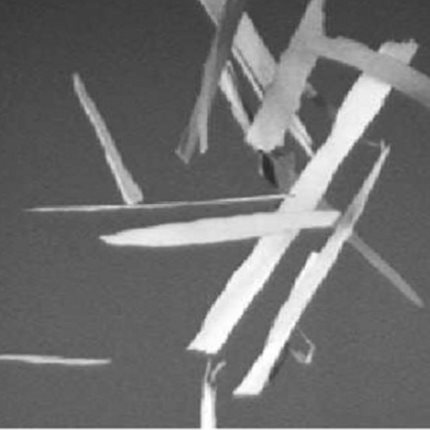
-
Environmental informatics
Innovative algorithms and methods based on multidimensional signal processing, computational intelligence techniques, and simulation techniques have been studied and realized for environmental monitoring and prediction systems. In particular, the research has been focused on advanced methods for wildfire detection systems based on the analysis of frame sequences captured at high distances using low-quality cameras and on the prediction of renewable energy using only weather forecasts or the information of energy unbalance in smart grids. Privacy issues and solutions in environmental monitoring systems have also been considered.
9.4. Intrusion detection systems
Artificial intelligence-based methods have been designed and developed for the adaptive detection of intrusions from heterogeneous datasets containing network activity logs. The proposed techniques achieved high accuracy in distinguishing benign network traffic from malicious traffic, while also enabling the classification of different types of intrusions. In particular, adaptive sizing methods for neural architectures have been designed and implemented to match the complexity of each specific dataset, also in synergy with knowledge transfer techniques, thus improving compatibility across heterogeneous databases. Moreover, innovative methods in federated learning scenarios have been studied and realized to select the best data to use for training and to to detect attacks, with the purpose of increasing the accuracy and robustness of intrusion detection approaches.9.5. Biometric systems
In the field of biometric systems, the research activities have regarded the design and realization of innovative solutions consisting in original hardware systems, software algorithms, and biometric methodologies for recognizing individuals in security applications using physiological traits and soft biometric features. The proposed methods enabled to reduce operational constraints of traditional biometric systems and allow a high-accuracy recognition using less-constrained and high-usability acquisition procedures. In particular, the research focused on touchless and less-constrained biometric systems and on high-usability touch-based systems.- Touchless and less-constrained biometric systems
In this context, the activities have been focused on innovative touchless and less-constrained acquisition procedures with a high usability, on new methods for the encoding of signal and images with a high level of noise, and on original methods for the comparisons of identities. In particular, different biometric traits have been studied. - Touchless and less-constrained fingerprint recognition
Innovative hardware systems, algorithms and biometric methods have been studied and realized for the recognition of fingerprints captured using less-constrained acquisition procedures, without the contact of the finger with the sensor. A particular focus has been given on the techniques for the processing of three-dimensional models for real-time identity comparisons and forensic applications. Methods for the extraction and analysis of features from samples captured using a single camera, mobile devices, as well as captured from heterogeneous sources, have been studied and realized. Methods for the quality estimation and the generation of synthetic of three-dimensional models have also been proposed. -
2-D touchless fingerprint recognition
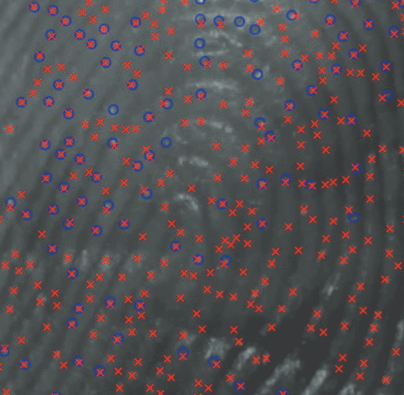
-
3-D touchless fingerprint recognition
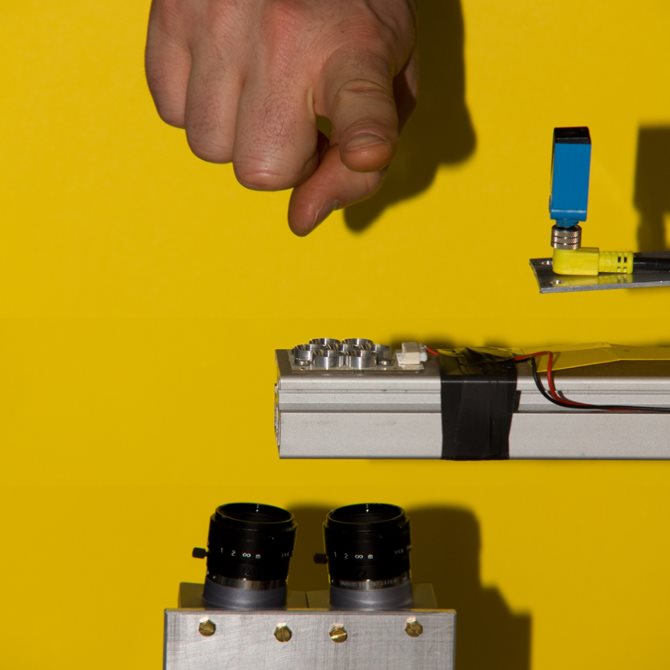
-
3-D models for ancient fingerprints

- Touchless and less-constrained palmprint recognition
Innovative hardware systems, algorithms and biometric methods have been studied and realized for the recognition of palmprints captured using touchless and less-constrained acquisition procedures, without the contact of the hand with any surface. A specific focus has been given to novel Deep Learning-based techniques using original Convolutional Neural Networks, designed to extract highly-discriminative biometric features from palmprint images, trained using innovative unsupervised procedures. Original techniques based on Convolutional Neural Networks for the fusion of palmprint and finger texture features have also been proposed to increase the accuracy of the biometric recognition. The research also focused on new techniques for processing three-dimensional models and using pattern recognition methods for comparing samples captured with different positions and orientations. - Touchless and less-constrained recognition using soft biometric traits
Innovative hardware systems and algorithms, based on multidimensional signal processing and computational intelligence techniques, have been studied and realized for the estimation of the weight of walking individuals in surveillance applications using touchless and un-obtrusive acquisition procedures. Multidimensional signal processing and computational intelligence techniques have also been used to estimate the age of the individuals using face images captured using un-obtrusive procedures. Explainable Artificial Intelligence techniques have been studied to analyze the learning process of Deep Learning-based methods that use Generative Adversarial Networks to synthetically age face images. - Less-constrained iris recognition
The research focused on studying the problems related to iris recognition and user tracking in security contexts, using public-domain images present on the internet and social media. To this purpose, the research activities also included the collection and publication of the first database, available to the public, of iris samples extracted from face images captured in less-constrained conditions and from images freely downloadable from the internet. The research acitivities included also the realization of an innovative methodology based on Generative Adversarial Networks to ensure the biometric anonymization of the iris in such images, at the same time maintaining a high visual realism of the obtained images. - Highly-usable touch-based biometric systems
Recent advances in biometric recognition for Automated Border Control (ABC) systems have been studied along with emerging technologies. Innovative algorithms and original biometric methods based on multidimensional signal processing and computational intelligence techniques have been studied and realized for a more accurate, fast, and highly-usable touch-based fingerprint recognition in new-generation Automated Border Control systems. In these applications, the research has focused on multimodal biometric systems, on techniques for the classification of acquisition problems affecting fingerprint images, and on methods for biometric score normalization.
See also the Research page.
10. Publications
See the Publications page.

 Google Scholar
Google Scholar Scopus
Scopus GitHub
GitHub DBLP
DBLP


